Rockets and Satellites Guided Reading and Study Answer Key
Summary
How do we communicate with each other? How do we communicate with people who are close by? How do we communicate with people who are far away? In this lesson, students explore the role of communications and how satellites help people communicate with others far away and in remote areas with nothing around—that is, no obvious telecommunications equipment. Students learn about how engineers design satellites to benefit life on Earth. They are also introduced to the theme of the Rockets unit.This engineering curriculum aligns to Next Generation Science Standards (NGSS).
Engineering Connection
Satellites have been used for years for various purposes including scientific research, weather reporting, communications, navigation and even for observing Earth. Engineers have played a key role in designing these satellites, getting them into orbit, and using the information they relay back to Earth. Communicating with people has always been an important part of human existence. As people live further away from each other, and as they explore more and more remote regions, communication with each other becomes even more important.
Learning Objectives
After this lesson, students should be able to:
- List several different types of satellites that have been designed by engineers.
- Describe how a satellite phone receives and transmits signals for communication.
- Explain the concept of an orbit and give examples of several things that orbit.
Educational Standards Each TeachEngineering lesson or activity is correlated to one or more K-12 science, technology, engineering or math (STEM) educational standards.
All 100,000+ K-12 STEM standards covered in TeachEngineering are collected, maintained and packaged by the Achievement Standards Network (ASN), a project of D2L (www.achievementstandards.org).
In the ASN, standards are hierarchically structured: first by source; e.g., by state; within source by type; e.g., science or mathematics; within type by subtype, then by grade, etc.
Each TeachEngineering lesson or activity is correlated to one or more K-12 science, technology, engineering or math (STEM) educational standards.
All 100,000+ K-12 STEM standards covered in TeachEngineering are collected, maintained and packaged by the Achievement Standards Network (ASN), a project of D2L (www.achievementstandards.org).
In the ASN, standards are hierarchically structured: first by source; e.g., by state; within source by type; e.g., science or mathematics; within type by subtype, then by grade, etc.
NGSS: Next Generation Science Standards - Science
| NGSS Performance Expectation | ||
|---|---|---|
| 5-PS2-1. Support an argument that the gravitational force exerted by Earth on objects is directed down. (Grade 5) Do you agree with this alignment? Thanks for your feedback! | ||
| Click to view other curriculum aligned to this Performance Expectation | ||
| This lesson focuses on the following Three Dimensional Learning aspects of NGSS: | ||
| Science & Engineering Practices | Disciplinary Core Ideas | Crosscutting Concepts |
| Support an argument with evidence, data, or a model. Alignment agreement: Thanks for your feedback! | The gravitational force of Earth acting on an object near Earth's surface pulls that object toward the planet's center. Alignment agreement: Thanks for your feedback! | Cause and effect relationships are routinely identified and used to explain change. Alignment agreement: Thanks for your feedback! |
International Technology and Engineering Educators Association - Technology
- The processing of information through the use of technology can be used to help humans make decisions and solve problems. (Grades 3 - 5) More Details
View aligned curriculum
Do you agree with this alignment? Thanks for your feedback!
- Information can be acquired and sent through a variety of technological sources, including print and electronic media. (Grades 3 - 5) More Details
View aligned curriculum
Do you agree with this alignment? Thanks for your feedback!
State Standards
Suggest an alignment not listed aboveWorksheets and Attachments
Visit [www.teachengineering.org/lessons/view/cub_rockets_lesson01] to print or download.More Curriculum Like This
Upper Elementary Activity 
I'm Not in Range: Acting Out Cellular Phone Service
In this role-playing activity, students learn how cellular phone service works, its advantages and its limitations. Students also learn about the advantages and limitations of satellite phone service.

Upper Elementary Lesson 
Where Am I: Navigation and Satellites
Students explore the concept of triangulation that is used in navigation satellites and global positioning systems designed by engineers. Also, students learn how these technologies can help people determine their positions or the location of someone else.

Upper Elementary Lesson 
Newton Gets Me Moving
Students explore motion, rockets and rocket motion while assisting Spacewoman Tess, Spaceman Rohan and Maya in their explorations. First they learn some basic facts about vehicles, rockets and why we use them. Then, they discover that the motion of all objects—including the flight of a rocket and mo...

Upper Elementary Activity 
Find It!
Students learn the basic concept of global positioning systems (GPS) using triangulation and measurement on a small scale—within boxes in the classroom. They discover how GPS and navigation integrate mathematics and scientific concepts to create a standard for locating people and objects.

Introduction/Motivation
Spacewoman Tess and Spaceman Rohan's daughter Maya is heading off on a six-month solo canoe trip through northern Canada to previously unexplored waters. Spacewoman Tess and Spaceman Robert are very excited, though very worried about their daughter. If you were Maya's parents, what would you be worried about? If you were Maya herself, what would you be worried about?
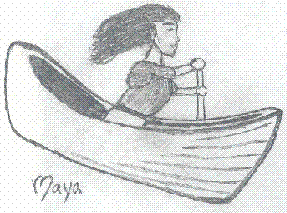
copyright
Copyright © 2005 Spacepeople created by Jay Shah, University of Colorado Boulder
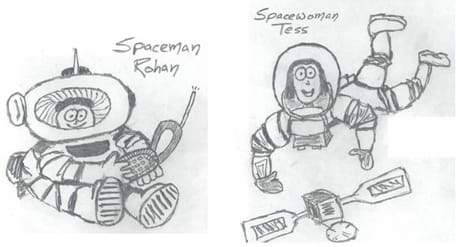
copyright
Copyright © 2005 Spacepeople created by Jay Shah, University of Colorado Boulder
They are all worried about being able to communicate with their daughter—to know where Maya is and that she is safe. Communicating is how we are able to get ideas or messages across to other —people. Let's brainstorm a list of different ways of communicating. (Possible answers: speaking, sign language, telephone, letters, body gestures, television, radio, email, websites, etc.) Which ways work well for people who are standing close together? (Possible answers: speaking, body gestures, sign language, newspaper, etc.) Which ways work well for people who are located apart, perhaps in different countries? (Write a list on the classroom board. Possible answers: telephone, email, television, radio, newspaper, Skype, snail mail, etc. If types of mass communication are not suggested, ask students how news is communicated, or what kind of television service they have at home. Leave this list on the board.)
What about knowing where you are located or where other people are located? Let's brainstorm ways that people can know where they are or where other people are located. (Possible answers: maps, calling people to ask them, identification markers, satellite navigation, left behind "bread crumbs." To get the answers flowing, ask how pilots know where they are in the huge open sky?) How do vehicles such as aircraft or ships, or even some cars know where they are at any given time? (Possible answers: maps, global positioning satellite systems, identification markers, radar, etc. Leave this list on the board as well.)
Teacher class demonstration: Before class begins, attach a string to a ping pong or tennis ball. Hold the string/ball out in front of you, letting the ball drop towards the ground. Holding the string between your fingers, begin twirling the ball in a circle using your wrist to obtain a smooth, consistent motion. When you have the ball turning in a constant motion, cut the string.
Let's think about what has happened with the ball. Have you ever looked up into the sky at night and seen something moving really slowly across the night sky? Chances are you were seeing a human-made object that was put into the Earth's atmosphere by engineers and is now orbiting the Earth. What is an orbit? An orbit is when an object moves around another object in a complete path, like a circle or an oval. What about the moon, what is it doing as it moves across the sky at night? (Answer: It is orbiting the Earth.) What about all of the planets in the solar system? Do they orbit? (Answer: Yes, they are all orbiting the sun.) In the demonstration, what was the ball orbiting before the string was cut? (Answer: It was orbiting the teacher's wrist/hands/fingers.) Show students Figure 1, an orbit schematic. Point out how the pull of a planet's gravity is always "down." But what does "down" mean? Does down mean the same thing for a person in Australia as it does for someone in the U.S.? (Answer: Yes and no. Yes because down is always towards the center of the Earth (center of mass), no because this "down" would be two very different directions—almost opposite!.) The important thing to remember is: GRAVITY ALWAYS PULLS DOWN, TOWARDS THE CENTER OF MASS OF THE PLANET. If something is in orbit (such as a satellite), it means that it is falling AROUND earth—and not just to its surface.
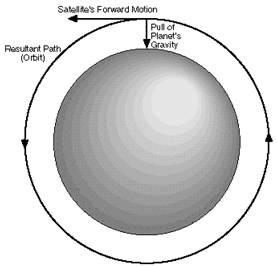
copyright
Copyright © NASA http://quest.arc.nasa.gov/space/teachers/rockets/images/satellite_orbit.gif
The common theme we have discussed so far is satellites. Engineers design and build satellites for different types of communication. Some satellites are used for communication between people, while other satellites send data to be processed to computers on Earth. Hundreds of satellites orbit the Earth for various purposes, including scientific research, weather research and prediction, navigation and observation of the Earth. Did you know that the Earth even has a natural satellite? Do you know what it is? (Answer: The moon!) People can communicate via satellites and even know exactly where satellites are being utilized. So, how can Spaceman Rohan, Spacewoman Tess and Maya use a satellite for their benefit? (Give time for students to answer. Possible answers: to find/confirm their locations and to talk to each other.)
Human-made—or artificial—satellites orbit the Earth, receiving and transmitting signals. Basically, a signal is sent from a computer or a person in one location on Earth up to a satellite that is orbiting the Earth, and then back down to another person or computer somewhere else. By using orbiting satellites in space, Spaceman Rohan and Spacewoman Tess will be able to communicate with Maya by using a satellite phone. Can you guess how this phone works? A satellite phone is a mobile phone that transmits (sends) signals to an orbiting satellite that receives the signal, and then transmits them to another phone. Maya's parents can definitely use a satellite phone to communicate with her. Maya can even use satellites to help her figure out exactly where she is during her trip using a technology we call GPS, which stands for global positioning system. GPS is a navigation system that uses a special type of satellite that records locations of signals and sends the coordinates of that location back to another transmitter or computer. Today, we are going to learn some more about satellites and how engineers have designed them for different forms of communication.
Lesson Background and Concepts for Teachers
Orbits
Figure 2 illustrates how an artificial satellite can orbit the Earth. The pull of Earth's gravity is always towards its center, so a satellite in space is always pulled "down" towards the ground. This falling, combined with a fast enough forward speed, enables a satellite to fall "around" the Earth. In theory, if a cannon is fired fairly weakly, the path of the cannonball will be that of a parabolic arc, landing perhaps a few hundred yards away. Frame 1 shows a cannon using a little more gunpowder, which causes the cannonball to shoot a little bit farther. In this situation, the ball lands perhaps a few hundred miles away. We can see just a little of the Earth's curvature, but it does not really affect anything. In the frame 2, using a super-shooter, the cannonball is shot hard enough that it travels several thousand miles. This frame illustrates that the curvature of the Earth has had an effect. The ball travels much farther than it would have had the Earth been flat. Finally, in frame 3, a mega-super-big cannon fires the cannonball at the unbelievable velocity of 5 miles/second (nearly 17,000 miles/hour; the fastest jet planes can fly two or three thousand miles/hour). The result of this shot is that the ball misses the Earth as it falls.
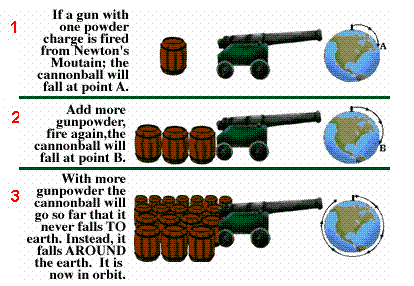
copyright
Copyright © NASA http://www.nasa.gov/
However, the Earth's gravitational pull causes it to both continuously change direction and continuously fall. The result is a "cannonball" that orbits the Earth. Note that in the absence of gravity, however, the original throw (even the shortest, slow one) would have continued in a straight line, leaving the Earth far behind.
Satellites
An artificial satellite is a manufactured object that orbits Earth or something else in space on a continual basis. Satellites are used to study the universe, help forecast the weather, transfer telephone calls and assist in ship and aircraft navigation. Specifically, communications satellites serve as relay stations, receiving radio signals from one location and transmitting them to another. A communications satellite can relay several television programs or many thousands of telephone calls at once. They essentially bounce messages from one part of the world to another.
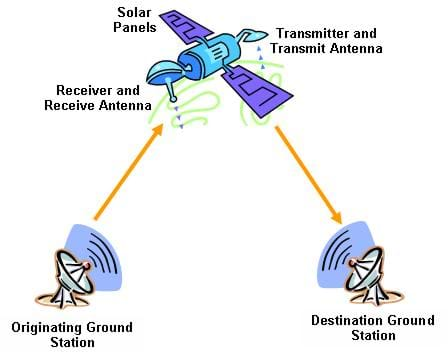
copyright
Copyright © 2005 Janet Yowell, University of Colorado Boulder, using clipart from (c) 2004 Microsoft Corporation, One Microsoft Way, Redmond, WA 98052-6399 USA. All rights reserved.
Every communications satellite involves the transmission of information from an originating ground station to the satellite, followed by a retransmission of the information from the satellite back to the ground (see Figure 3). The retransmission may either be to a select number of ground stations or broadcast to everyone in a large area.
Space shuttles carry some satellites into space, but most satellites are launched by rockets that fall into the ocean after the fuel is used up.
Cellular Phones and Satellite Phones
A cellular phone can be described as a very sophisticated radio. They are a type of wireless communication device that uses many small cells with a base station and a cell phone tower at the center of each cell. Refer to the associated activity I'm Not in Range: Acting Out Cellular Phone Service to teach students about cellular phone and satellite phone communication by creating models to demonstration their knowledge. These cells have extensive frequencies that allow many thousands of people to use cell phones at the same time. In this process, cellular calls are transferred from base station to base station as a user travels from cell to cell. A cellular network is composed of cellular towers. In essence, when a call is placed from your cell phone, it travels by radio waves to a cellular tower that picks up the specific signal from your phone. These cellular towers are thought of as cells, with each cell able to typically pick up a signal within 10 square miles. Then the signal is sent to a mobile telephone switching office (MTSO) that handles calls from several towers—called a cluster. The MTSO transfers the signal to a local phone line that sends the signal to the final destination via landline, microwave signals or satellite. The MTSO senses when the signal is becoming weak and hands your call off to the next tower—or the MTSO in the next cluster. It controls the quality of your link by keeping you connected to the best possible signal as you move from cell to cell. When you have traveled beyond the range of the towers, the signal is lost and you cannot make or receive calls.
Satellite phones do not use cells or cell towers for sending/receiving calls. Most satellite phones use low earth orbiting (LEO) communication satellites. When a satellite phone is turned on, the signal goes up to any number of satellites in a compatible constellation (group of satellites) where it is registered with the constellation. When a call is made through the satellite phone, the signal goes to the satellites and then is directed down to a ground station and then further directed to the call destination. The call can be directed to a land-line as well as a cellular network and the reverse is also true. This process allows the satellite phone to be used in the middle of nowhere—great distances from any cellular phone tower—thus providing an essential form of communication for those who travel to the beyond!
Associated Activities
- I'm Not in Range: Acting Out Cellular Phone Service - Students learn about cellular phone and satellite phone communication. They create models to demonstration their knowledge.
Lesson Closure
In this lesson, we learned that engineers design satellites for a variety of purposes, including communication. Many of these satellites are in orbit around the Earth. They stay in orbit using the Earth's natural gravitational force. Rockets and other spacecraft are used to launch the satellites into orbit. Satellites receive signals from one person or computer and transmit them to somewhere else. These satellites help people receive information from around the world in regards to news, weather, location, research and just the latest word from a friend. Can you remember some examples of specific satellite technologies designed by engineers? (Possible answers: satellite phones, global positioning satellites.)
Now that we better understand some methods of communication, Spacewoman Tess, Spaceman Rohan and Maya have options available to them so they can stay in touch with Maya, even in the middle of nowhere.
Vocabulary/Definitions
constellation: An easily recognized group of stars or satellites that appear to be located close together in the sky.
gravity: The force by which a planet or other celestial body tends to draw objects toward its center.
low Earth orbiting: When a satellite circles close to Earth (200-500 miles high), it is in low Earth orbit (LEO). Because satellites orbit so close to Earth, they must travel very fast (17,000 miles per hour) so that gravity does not pull them back into the atmosphere.
navigation: The science and technology of finding the position and directing the course of vessels and aircraft.
orbit: The path of a celestial body or an artificial satellite as it revolves around another body.
parabolic: Plane curve consisting of all points equidistant from a given fixed point and a given fixed line.
satellite: An object that travels (orbits) around another object, while under the influence of a gravitational force.
Assessment
Pre-Lesson Assessment
Discussion Question: Solicit, integrate and summarize student responses.
- Ask students to individually think about their mornings and write down all of the different forms of communication they may have used or have seen used. (Possible answers: talking—to a person or on the phone, reading—a book, the newspaper or the classroom board, text messaging; leaving a hand-written note, etc.)
- Ask students if they know anyone who lives very far away from them and how they communicate with that person? Or, do other people far away communicate with them? Discuss how these methods of communication differ from communicating with someone who lives nearer to them.
- Ask students why they think all planets in our solar system orbit the sun? (Answer: Since the sun is so massive and heavy, about 333,000 times the mass of the Earth, it attracts everything in our solar system with it's gravity. This causes the planets and stars to "fall," or orbit around the sun.)
Post-Introduction Assessment
Diagramming: Organize the class into groups of two or three students each, and ask them to work togetherh to each draw a picture of a communications satellite orbiting the Earth. Require them to include as much detail as possible in their diagrams, making sure to label all components, sketch the satellite's orbit, draw an arrow representing the pull of gravity down towards the center of Earth, and an arrow pointing in the direction of travel.
Post-Lesson/Lesson Summary Assessment
Diagramming/Reiteration: In their groups, have students look again at their pictures of communications satellites orbiting the Earth. Have them discuss if they have suggestions for anything to add to or remove from each picture to improve it.
Communication and Satellite Jeopardy: Divide the class into groups of three or four students each. Using Table 1, ask student teams to pick a category and dollar amount. (Note: Use the Communication and Satellite Jeopardy Overhead PDF file as an overhead transparency or handout; it is the same chart as Table 1, but without the questions.) Read aloud the answer corresponding to the dollar amount and category. Student groups must come up with the question (that is, a student says: "I'll take 'Communication' for 400, please." The teacher reads the answer: "This form of communication uses the computer to type and send messages that are read by their recipient on another computer via the internet." To win the $400, the students must come up with the question: "What is email?").
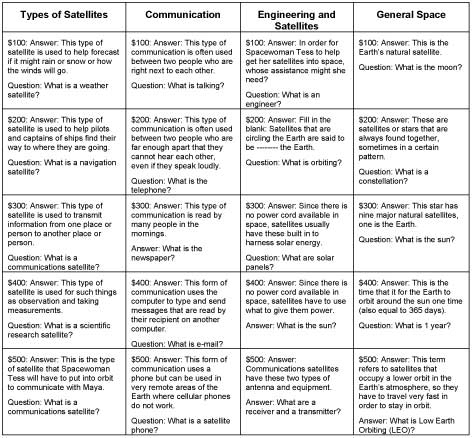
Lesson Extension Activities
Have students investigate other methods of communication that use and do not use technology. Ask them to answer questions, such as: what types of communication did people in Asia use in the 19th century? What types of communication do specific animals use? What types of communication might people without communication technology—who are in distress—use?
Have students research what other types of satellites do and why they also might be useful. Challenge students to find pictures or other information that was generated via an Earth-orbiting satellite.
Have students make models of satellites including the power-generating devices, the receiver and transmitting antenna and devices, etc.
References
Abby, Mary Kay and Reda, Ellena. "I've got Your Number: Mathematics for Telecommunications," Lab 10, The Math Works Project, Montgomery Community College, MD, and Dutchess Community College, NY. www.ccc.commnet.edu
NASA's Observatorium, "Satellite Orbits." www.nasa.gov
Oberright, John E. "Satellite, Artificial." World Book Online Reference Center, 2004, World Book, Inc. www.worldbookonline.com
Gobalcom Satellite Communication, Decatur, IL. www.globalcomsatphone.com
Copyright
© 2006 by Regents of the University of ColoradoContributors
Jay Shah; Malinda Schaefer Zarske; Janet YowellSupporting Program
Integrated Teaching and Learning Program, College of Engineering, University of Colorado BoulderAcknowledgements
The contents of this digital library curriculum were developed under grants from the Fund for the Improvement of Postsecondary Education (FIPSE), U.S. Department of Education and National Science Foundation (GK-12 grant no. 0338326). However, these contents do not necessarily represent the policies of the DOE or NSF, and you should not assume endorsement by the federal government.
Last modified: November 16, 2021
Rockets and Satellites Guided Reading and Study Answer Key
Source: https://www.teachengineering.org/lessons/view/cub_rockets_lesson01
0 Response to "Rockets and Satellites Guided Reading and Study Answer Key"
Post a Comment